ADHD Goals and Objectives Examples
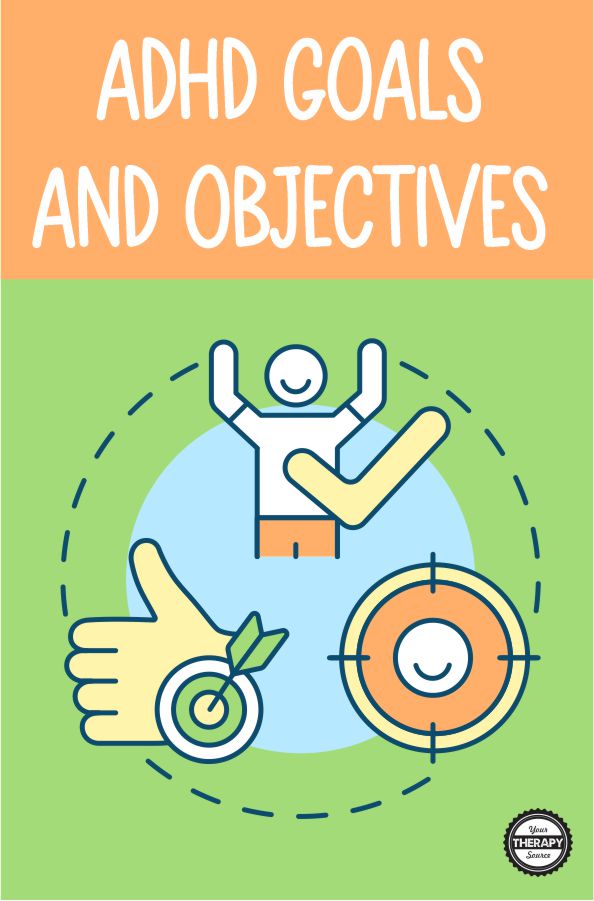
Attention Deficit Hyperactivity Disorder (ADHD) can present various challenges, especially for children trying to navigate their academic and social lives. These challenges necessitate the development of specific goals and objectives in an Individualized Education Program (IEP). This guide provides ADHD goals and objectives examples for parents, special education teachers, and IEP teams to help children with ADHD make significant strides in focus, organization, planning, and more. Remember that each child is an individual with unique circumstances when you establish functional goals and make them measurable goals.
DIFFERENT TYPES OF ATTENTION AND ADHD GOALS FOR EACH
Understanding the different types of attention—selective, sustained, alternating, and divided—is integral to developing effective goals. Understanding the different types of attention – selective, sustained, alternating, and divided – is key to developing appropriate ADHD goals and objectives. Selective attention involves focusing on one task amidst distractions. Sustained attention is maintaining focus over a long period. Alternating attention refers to the ability to switch focus between tasks, while divided attention is multitasking effectively.
Here are examples of ADHD goals for each type of attention:
Selective Attention:
- “The student will complete class work with 80% accuracy amidst classroom distractions for four weeks, as measured by teacher observations.”
- “For a week period, the student will focus on independent tasks, ignoring distractions, with 75% accuracy, as observed by the teacher.”
- “The student will follow a 3-step command amid distractions with 80% accuracy over a six-week period.”
Sustained Attention:
- “Over the school year, the student will increase their attention span from 10 to 30 minutes during direct instruction, as measured by teacher observations.”
- “The student will stay on a non-preferred task for an increasing period, from 15 minutes to 30 minutes, over an 8-week period, as measured by teacher observation.”
- “For 4 consecutive weeks, the student will focus on an academic task for 20 minutes without interruptions, as documented by teacher observations.”
Alternating Attention:
- “Within a nine-week period, the student will switch between two different tasks without loss of accuracy, as observed by the teacher.”
- “The student will transition smoothly between different subjects, maintaining work accuracy, over the course of a semester, as documented by academic grades.”
- “For the rest of the school year, the student will efficiently alternate attention between listening to instruction and taking notes with a success rate of 80%, as measured by teacher observation.”
Divided Attention:
- “Over the school year, the student will demonstrate improved multitasking skills, such as note-taking during lectures, with a 20% increase in accuracy as measured by teacher observations.”
- “The student will improve their ability to simultaneously listen to instruction and complete class work, increasing accuracy by 15% over the next quarter.”
- “By the end of the semester, the student will accurately follow a lecture while writing down key points, increasing note accuracy by 25%, as documented by teacher observation.”
ADHD GOALS AND OBJECTIVES EXAMPLES FOR FOCUS
Focus is a common challenge for children with ADHD. Goals for improving focus may include:
- “Over a six-week period, the student will accurately follow two-step instructions, without reminders, in four out of five instances, as measured by teacher observation.”
- “By the end of the school year, the student will increase the time spent on independent tasks from 15 minutes to 30 minutes without adult assistance, as documented by teacher observations.”
- “Over the course of the semester, the student will improve their ability to complete independent tasks with fewer than two reminders, in 7 out of 10 trials.”
ADHD GOALS FOR ORGANIZATION SKILLS
Improving organization skills is often a key objective for students with ADHD. Goals for enhancing these skills might include:
- “Over a 9-week period, the student will use organizational tools, such as color-coded folders, to manage class assignments, improving from 60% to 80% accuracy, as measured by teacher observations.”
- “By the end of the school year, the student will correctly record and turn in homework assignments 90% of the time, as documented by the teacher.”
- “The student will use an agenda or planner to keep track of assignments and due dates with 85% accuracy over the next semester.”
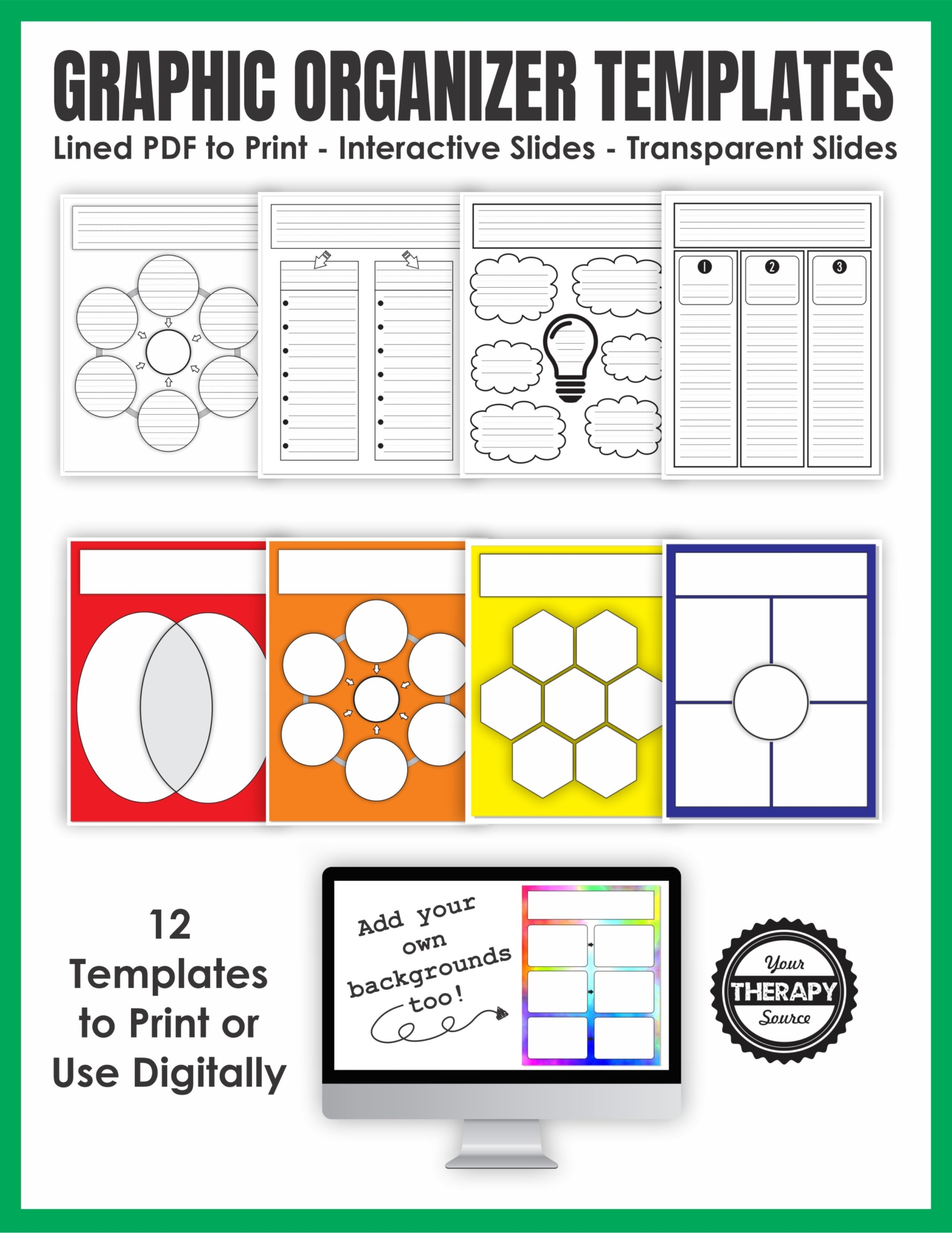
Graphic Organizer Templates – Print and Digital
ADHD GOALS AND OBJECTIVES EXAMPLES FOR PLANNING
Students with ADHD can also struggle with planning. Below are some goal examples to address this:
- “By the end of the semester, the student will utilize a planner to track assignments and due dates with 80% accuracy, as measured by teacher observations and agenda checks.”
- “Over a 9-week period, the student will use a checklist to complete multi-step tasks, increasing from 70% to 90% accuracy.”
- “The student will plan and execute a project, including dividing the project into steps, working on it consistently, and turning it in by the due date, in 3 out of 4 instances over the school year.”
ADHD GOALS FOR EMOTIONAL CONTROL
Regulating emotions can be a challenge for children with ADHD, often leading to outbursts or shutdowns when overwhelmed. Here are some goal examples related to improving emotional control:
- “Over a six-week period, the student will utilize appropriate coping strategies such as deep breathing, counting, or taking a quiet space break in response to stressful situations in 7 out of 10 instances, as observed by the teacher.”
- “By the end of the school year, the student will verbalize their feelings and needs when upset, rather than engaging in disruptive behavior, in 8 out of 10 instances, as documented by the teacher.”
- “The student will demonstrate appropriate emotional responses in a small group setting, reducing unexpected behavior by 25% over a 9-week period.”
- “Within a semester, the student will accurately identify and communicate their expected emotional state using a green zone (calm), yellow zone (frustrated), red zone (upset) system in 80% of the opportunities given.”
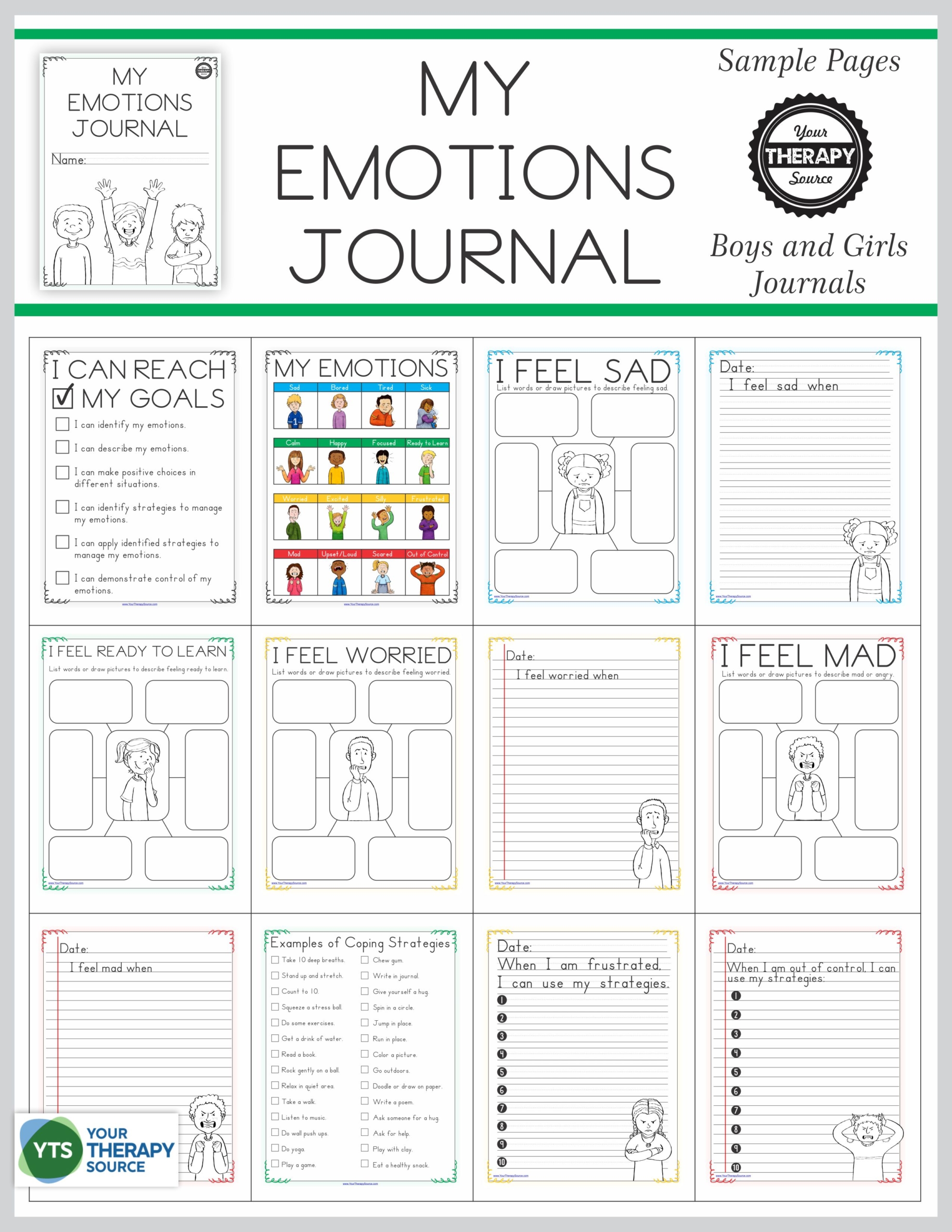
Emotional Regulation Worksheets – For Boys and Girls
ADHD GOALS AND OBJECTIVES EXAMPLES FOR TIME MANAGEMENT
Time management is a skill that can be particularly challenging for students with ADHD, but it’s also incredibly important for academic success and everyday functioning. Here are examples of goals for improving time management:
- “Over the course of the semester, the student will utilize a timer or alarm to independently begin and end tasks on time in 7 out of 10 instances, as observed by the teacher.”
- “By the end of the school year, the student will accurately estimate and allocate appropriate time for task completion (e.g., homework assignments, classwork, or personal chores) with 80% accuracy, as measured by teacher and parent observations.”
- “The student will use an assistive technology tool, such as a visual timer or scheduling app, to stay on schedule for daily activities, improving from 60% to 80% accuracy over a nine-week period.”
- “Over a six-week period, the student will use breaks effectively, limiting break time to the allotted period (e.g., 10 minutes) and resuming work immediately after, in 8 out of 10 instances, as documented by teacher observation.”
Through the use of these goal examples and consistent practice, students with ADHD can improve their time management skills, which are crucial for academic success and independent living.
ADHD GOALS AND OBJECTIVES EXAMPLES FOR SELF-REGULATION SKILLS
Self-regulation skills are vital for managing ADHD symptoms, helping students to control impulses, manage emotions, and maintain focus. Here are examples of goals related to improving self-regulation skills:
- “Over a nine-week period, the student will engage in positive self-talk, deep breathing, or other relaxation techniques to manage stress during non-preferred tasks, with a success rate of 80%, as measured by teacher observation.”
- “The student will utilize self-regulation strategies, such as using a fidget tool, self-monitoring checklists, or taking a movement break, to maintain focus during class time, increasing from 60% to 80% of the time over the school year.”
- “By the end of the semester, the student will independently use a visual self-rating system to monitor their anxiety, stress, or calm body level and take appropriate self-regulation actions in 8 out of 10 instances.”
- “Over the school year, the student will use strategies like physical activity, deep breathing, or heavy work activity to regulate emotions and energy level during transitions and unexpected schedule changes in 7 out of 10 instances, as observed by staff members.”
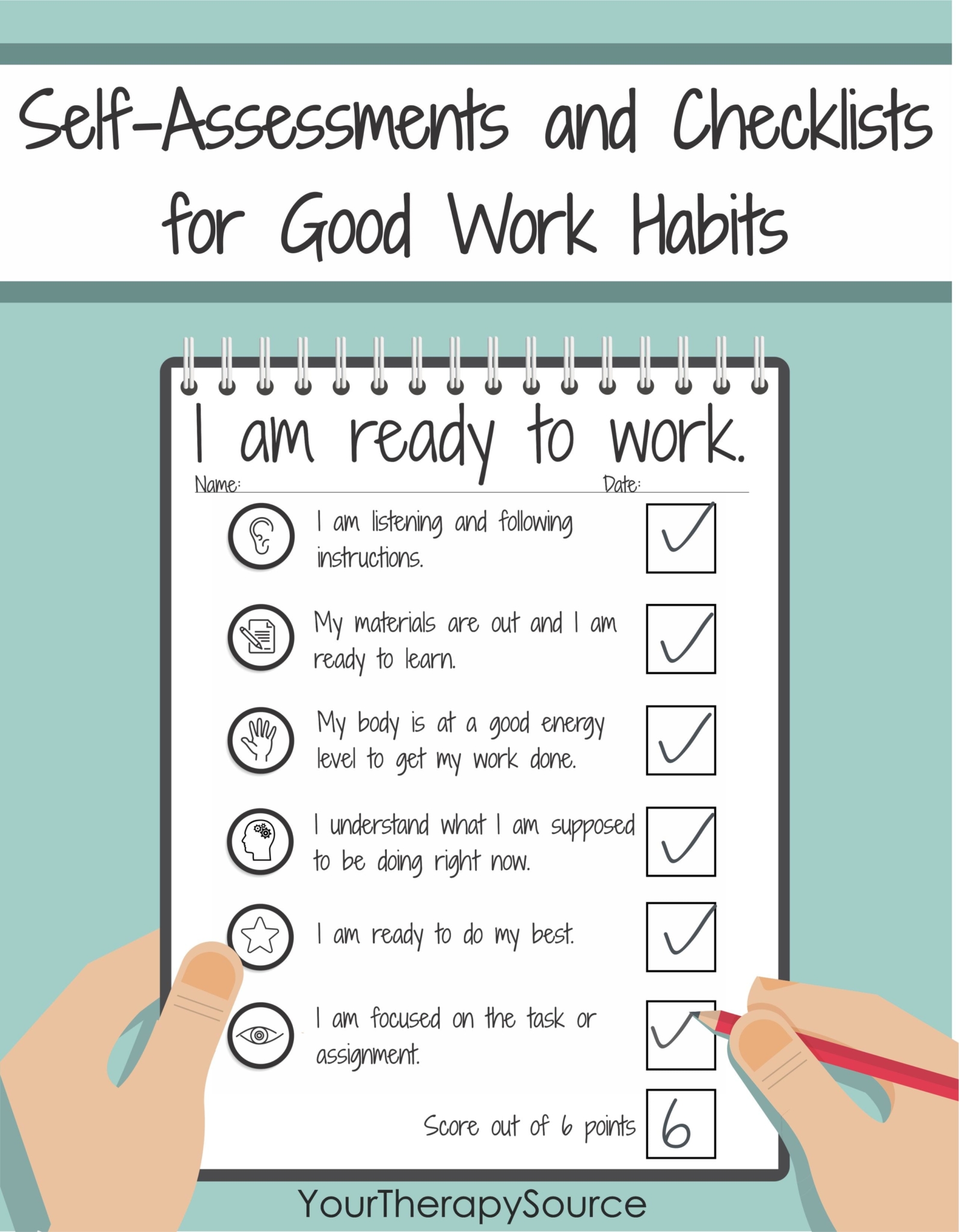
Self-Assessments and Checklists for Good Work Habits
ADHD GOALS RELATED TO “SIZE OF THE PROBLEM”
Understanding the “size of the problem” is essential for children with ADHD, as it helps them formulate an appropriate emotional response to various situations on a daily basis. Here are a few goals to improve a student’s ability with regards to emotional regulation and the size of the problem:
- “Over the course of the semester, the student will accurately gauge the ‘size of the problem’ (small, medium, large) and match their emotional response accordingly, in 8 out of 10 instances, as observed by the teacher during counseling sessions and in the classroom setting. This goal can be measured using a visual scale or checklist to track the student’s progress in matching their responses to the size of the problem.”
- “By the end of the school year, the student will use problem-solving strategies, such as determining the ‘size of the problem’ and selecting an appropriate response, in 8 out of 10 opportunities, as measured by the teacher through role-play scenarios and real-life situations.”
- “Over a nine-week period, the student will decrease instances of overreaction to small problems (i.e., reactions not matching the ‘size of the problem’) by 50%, as documented by teacher and staff observations in various settings such as classroom, playground, and cafeteria.”
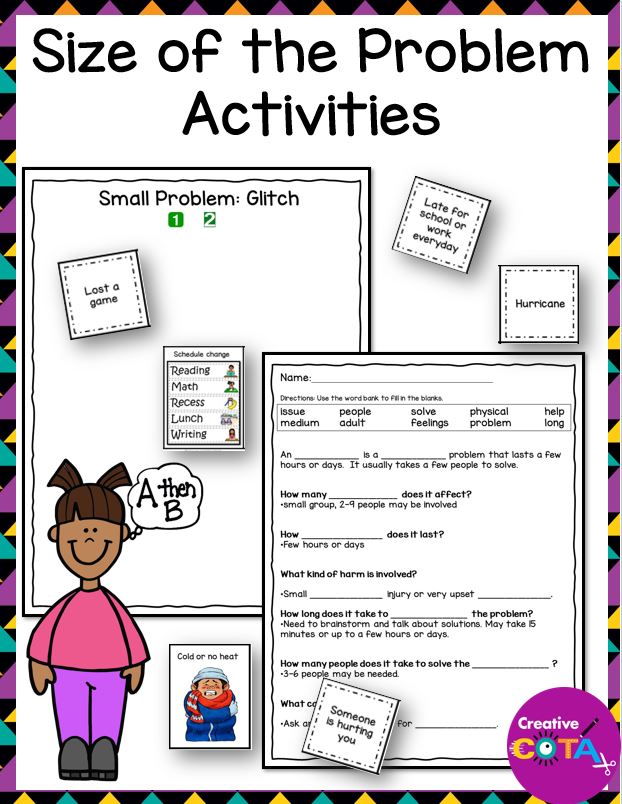
Size of the Problem Visual Supports and Activities
ADHD GOALS AND OBJECTIVES EXAMPLES FOR FINE MOTOR SKILLS
Fine motor skills, which involve the coordination of small muscles in the hands and fingers, can often be a challenge for students with ADHD. Here are examples of goals for improving fine motor skills:
- “Over a six-week period, the student will improve handwriting legibility, writing at least five sentences with all words legible to the reader in 8 out of 10 instances, as measured by teacher evaluation.”
- “By the end of the school year, the student will demonstrate improved fine motor skills by using scissors to accurately follow along a line or shape in 7 out of 10 trials, as observed by the teacher.”
- “Over a nine-week period, the student will increase their typing speed from 15 words per minute to 25 words per minute with fewer than two errors per minute, as measured by a standard typing test.”
- “The student will demonstrate improved grip strength and dexterity by using small manipulatives (beads, pegs, blocks) to complete a task within a specified time limit, improving speed and accuracy by 25% over the school year.”
These goal examples aim at improving fine motor skills, which are crucial for academic tasks such as writing, cutting, and keyboarding, as well as daily life skills. With the collaborative efforts of the student, teachers, and occupational therapists, these goals can contribute significantly to the overall success and independence of the student with ADHD.
ADHD GOALS AND OBJECTIVES EXAMPLES FOR USE OF ASSISTIVE TECHNOLOGY
Assistive technology can be a game-changer for students with ADHD, helping them overcome barriers and improve their academic and functional performance. Here are examples of goals related to the effective use of assistive technology:
- “Over a nine-week period, the student will use an assistive technology tool, like a digital planner or reminder app, to keep track of assignments and due dates with 80% accuracy, as documented by teacher observations and planner checks.”
- “The student will utilize text-to-speech software to improve reading comprehension, aiming to increase their comprehension score from 70% to 85% accuracy over the course of the school year.”
- “Over a semester, the student will utilize speech-to-text software to complete writing assignments, increasing writing productivity and accuracy from 60% to 80%, as measured by teacher evaluation of assignments.”
- “The student will use a digital graphic organizer to structure writing assignments, improving the organization of written work from a score of 2 to a score of 4 on a 5-point rubric over the school year.”
- “Over a six-week period, the student will use an auditory prompting system to transition between tasks or activities independently, without adult prompts, in 7 out of 10 instances.”
Remember, effective use of assistive technology requires proper training and ongoing support for both the student and the teacher. This support, combined with well-defined goals, can empower students with ADHD to reach their full potential.
SMART GOALS
SMART goals are Specific, Measurable, Achievable, Relevant, and Time-bound. They are critical in managing ADHD as they enable a systematic approach to track a child’s progress throughout the school year. Below are some basic examples of SMART goals for students with ADHD:
- Behavioral Goal: “By the end of the school year, the student will effectively use self-regulation strategies like deep breathing and positive self-talk, with adult reminder if necessary, to maintain appropriate emotional responses to non-preferred tasks or stressful situations, in 8 out of 10 instances, as documented by a visual self-rating system.”
- Academic Goal: “The student will increase his/her math skills to the grade level as defined by the general education curriculum, improving from a score of 70% to 85% accuracy on all assignments and tests, over the course of the school year.”
- Functional Goal: “Over a 9-week period, the student will independently complete daily living tasks, such as organizing their personal items, in 8 out of 10 instances, as documented by teacher observation and data collection.”
These goal examples serve as a framework for establishing a well-rounded and individualized approach in addressing the unique needs and challenges of students with ADHD. Each student is different, and goals should be tailored to their specific needs. Collaboration between parents, teachers, and the IEP team is crucial for ensuring that goals are set and achieved, propelling each student towards a more successful educational experience.
GETTING THE RIGHT SUPPORT FOR STUDENTS WITH ADHD
Getting the right support for students with ADHD is vital for their academic and personal development. If your child has an Individualized Education Plan (IEP) or a 504 Plan, various professionals are available to assist. School counseling is often a valuable resource, providing strategies for emotional regulation, focus, and social skills. Related service professionals, such as speech-language pathologists or physical therapists, can offer support to address specific functional needs and promote successful participation in the general education curriculum.
Occupational therapists play an integral role in helping children with ADHD, and developing strategies to improve executive functions such as planning, time management, and organization skills. They can also help children develop sensory strategies to manage their attention and energy levels throughout school.
Special education teachers are invaluable in helping students with ADHD reach their academic goals. They are experienced in modifying and differentiating instruction, and they can work with general education teachers to make sure classroom settings are supportive and conducive to learning.
In addition, school psychologists can provide assessments to identify a student’s unique needs and work with teachers and families to develop and implement appropriate behavior intervention plans.
Lastly, assistive technology specialists can identify and implement technological solutions to help students with ADHD succeed acadically, including the use of software and devices that enhance reading, writing, and note-taking skills.
These professionals all collaborate as part of the IEP team to ensure that the individual needs of each student are met. They monitor the student’s progress towards their goals on a regular basis and adjust strategies as needed. Remember, the most successful plans are those that involve open communication and active partnership between the school and home.

RELATED RESOURCES
How to Write SMART Annual IEP Goals
Executive Functioning IEP Goals
SMART Goals – Examples for Students


